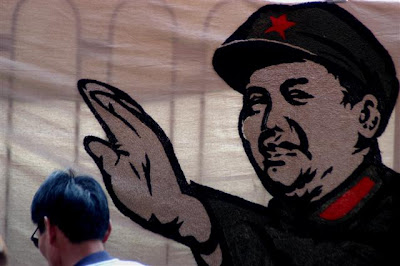.jpg)
Hong Kong: "The appetizer"
Postcard (Yela)
Arriving at Hong Kong one feels that it is China but no really, that is, is actually a special administrative region of China and one of the most important financial centers of Asia and the world, however it has an administrative and judicial system independent from mainland China, in a nutshell is China but decaffeinated.

Skyscrapers (Image by Juan Carlos)
Skyscrapers are distinguished from the plane, packed into the mist of a cloudy day, portraying a typical aesthetic grayscale image-postcard of Hong Kong. As far as which one enters the city people is perceived walking in a fast pace and with a sample size of seriousness, perhaps, the glamour and elegance of this city. Urban parades are displayed on the sidewalk, there locals go, dressed in gray and black with a briefcase in one hand and shopping bags in the other, saving time out of time, systemic gears. Certainly neither of us belong to this type of scenario, but it is impossible not to admire the architectural complexity and financial sense that this city has in the world, as well as the infrastructure that goes beyond extravagant luxuries, the largest electric escalator in the world or as the light show that gives life to Victoria Island skyscrapers, show that fascinate people standing on Kowloon Public Pier, contemplating the superb timing of lights, lasers and music. Walking the streets one gets stuck in every corner turned into a make-up commercial space with neon: food, technology, fashion, everything is for sale, everything is money in Hong Kong, cult to capitalism that leaves visitors with neck pain and if distracted with a hole in their pocket.

Lights and sound show. (Image by Juan Carlos)
China "The Great Feast"Since we started planning our trip, China accounted for both as the great feast. Constantly we referred to this part of the trip as "the main course, perhaps because none of us had been there and we were attracted by Asia's largest country, the world's most populous and with an ancient culture and history, deep and complex, in combination with an economy that in the world context, has earned strongly its prominent place. Great expectations-and in some ways romantic-, were about to confront the reality of a country with a vibrant development.
Our journey is filled with feelings of constant ambivalence. On the one hand we expected an encounter with one of the oldest civilizations in the world, and then our romantic idealization of the country was faced with the new China everyone speaks about, the overflowing development and growing economy. Countless unpronounceable cities growing vertically and horizontally out of proportion. Efficient urban infrastructure that maintain, protect and move people from one place to another around cities and country. However, in our journey the absence of rivers of bicycles is felt, they are gone because economic development have left them, along with some other customs, buried under the dust of oblivion.
.JPG)
Rickshaw (Image by Juan Carlos)
Yet in some corners of the country and its major cities still some architectural history of ancient China is saved, the one of gray walls and traditional roofs, the one with beautiful parks, lakes and rivers with bridges framed by beautiful trees and flowers, all giving the image that the world has of Chinese aesthetics. The museums leave you more amazed than normally; a country as big and as old as China is, necessarily has to produce such a sophisticated art that transcends borders and becomes universal.
Terracota warriors (Image by Juan Carlos)
The wonder of going back in time when you walk the Hutongs: alleys around the magnificent Forbidden City which, with its minute details and large dimensions one feels small among the ornamental and architectural immensity of the place. And obviously, we can not left behind talking about our visit to the imposing Great Wall of China, which constantly takes the visitor´s breath away when one stops to look into the distance how a line was imposed on the hills like a snake lost in the horizon; leaving us really impressed and amazed at the human effort involved in building such a wall. Similar sentiment is shared at the sight of the Terracotta Warriors, that despite being hundreds, each one is unique in itself, each impressive. With examples like these, one only confirms that in this country everything is big, powerful, effective, majestic and proud.
The Great Wall (Image by Juan Carlos)
And everyday tones, Chinese society likes to congregate around large feasts, food plays an important role. There is no celebration that is not done in the middle of delicious flavors, and then enriched with red fabrics embellished with yellow gold details that give flavor and color to China. Red is more than a color, a logo on their political bases (which are not realities), in its flag, its ornaments, courses, this color keeps the essence of this culture.
Hutong (Image by Juan Carlos)
The food is not only Chow Mein and Chop Suey (infinitely much more). There are great varieties of flavors produced from combinations of species and types of meat. Although we are vegetarians, a visit to local markets reveals the diversity of animals that are consumed in this country, from the traditional pork and fish, to exotic animals such as scorpions, turtles, snakes and even though we did not see it, is well known that also dogs and cats are consumed. But what is certainly wonderful is to try all possible combinations of vegetables and spices, but for that one indeed needs to be prepared and measured because the amount of oil used for everything is a heart risk and high probability of gaining weight as well.

Noodles making (Image by Juan Carlos)
On the other hand, politically wise, is interesting to see how free market policies go hand in hand with high levels of censorship, to the extent that some words can not be said in public plus the creation of "the new Great Wall," referring to censorship and control that the government has over the internet. However, you can not fail to recognize that in the sixty years that the Communist Party has been in power, with all the corruption, nepotism and repression they have, a miracle in this country has been made, because when one delves into the history of the country, it is surprising to see that over those years a leap have taken place from famine to be the second largest economy and biggest exporter in the world. However, you feel the social discontent, the country is like a pressure cooker; there are many educated people to keep subjugated in the Internet age. Some whisper that this is going to explode ... soon.
.JPG)
Mao's hand (Image by Juan Carlos)
Because, at shopping malls and restaurants, it seems that there are as many employees, trained in military style, as clients. Perhaps this strict regime is how to sustain such a populous country like this and as we do understand from Susu (one of our hosts) on the Chinese people is intrinsic the tradition of obedience and order. And yes, one can tell that in the people's mindset the idea that they are the next world power is set and so they are preparing for that, work for that and start living for that ... And as people are concerned, the individual, one finds everything, if you consider that 1 in every 5 people in the world is Chinese, makes it clear that one can find everything. There is the Chinese who wants to hold to money and does not skimp on details to do so, there is thee scholar who seriously questions the system in which they live and the direction they go. There is the romantic Chinese who wants to fight for their country to be the leading world power. The poor beggar on the street, the corrupt, the honest, the cheater, the worker, the old man, the philosopher, artist and the bohemian who feels the nostalgia of a legend. On several levels of interaction we met the daily Chinese, the one who has a family and maintains strong ties and respect with them. Since we were visiting former Juan Carlos´ students, we realized that they have a great sense of hospitality to visitors and plus the respect they have for teachers, then we often received a dedicated and generous attention at all times, which made this trip full of flavors, colors and which also offered deep reflections from China to the world and from the world to China.
.JPG)
Young Chinese (Image by Juan Carlos)
China undoubtedly gave us lots of excitement and big surprises. We enjoyed and endured today´s reality and having the expectations we had and being the penultimate country to visit, strong impressions fill our backpacks, to be digested and enjoyed in due time in the routine and comfort of home, but for the time being we again have to prepare luggage and return to America, the continent (no mistake with appropriation of the name from the United States, a name they share with all countries from Alaska to Argentina), and film the last child of the documentary, an African American girl to close this phase of the project.


.JPG)

.JPG)
.JPG)
.JPG)
.JPG)

.JPG)
.JPG)
.JPG)


+(Small).JPG)




+(Small).JPG)




.jpg)
.jpg)


.JPG)


.JPG)

.JPG)
.JPG)
.jpg)
.jpg)


.JPG)


.JPG)

.JPG)
.JPG)





.jpg)
.jpg)

